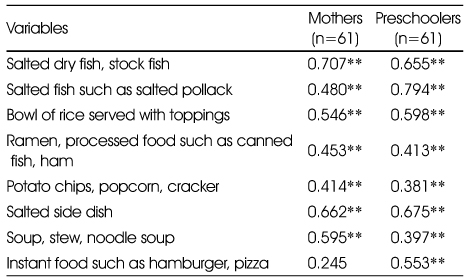References
1. Ahn SH, Kwon JS, Kim K, Yoon JS, Kang BW, Kim JW, Heo S, Cho HY, Kim HK. Study on the eating habits and practicability of guidelines for reducing sodium intake according to the stage of change in housewives. Korean J Community Nutr 2012;17(6):724–736.
2. Cho SK. Effects of the perception and education about sodium on children's dietary habits Kyung Hee University; 2011. 1–63.
MS Thesis.
3. Choe JS, Ji SM, Paik HY, Hong SM. A study on the eating habits and dietary consciousness of adults in urban area. J Korean Soc Food Sci Nutr 2003;32(7):1132–1146.
4. Chung KH, Shin KO, Choi KS, Yoon JA, Chung KH, Kim JS. Comparative study on nutrition attitudes, food purchase behaviors, and dietary habits of housewives living in Seoul and Kyunggi area. J East Asian Soc Diet Life 2012;22(2):163–174.
5. de Lauzon-Guillain B, Musher-Eizenman D, Leporc E, Holub S, Charles MA. Parental feeding practices in the United States and in France: relationships with child's characteristics and parent's eating behavior. J Am Diet Assoc 2009;109(6):1064–1069.
6. Han JS, Kim GS, Kim YH, Kim HO, Kim HJ, Park SM, Ahn CS, Han SH. New nutrition through the life cycle Paju: Jigu Publishing Co.; 2011. p. 120–128.
7. Her ES, Lee KH, Jang DS, Lee KY, Lee JH, Ju J, Yoon SY. A study food habits, food behaviors and nutrition knowledge among obese children in Changwon (I). J Korean Diet Assoc 1999;5(2):153–163.
8. Jung HJ. A study on nutrition knowledge, behavior, and preferred salinity in different age groups among Seoul citizens Myongji University; 2010. 4–82.
MS thesis.
9. Jung HR, Lee MJ, Kim KC, Kim JB, Kim DH, Kang SH, Park JS, Kwon KI, Kim MH, Park YB. Survey on the sodium contents of nursery school meals in Gyeonggi-do. J Korean Soc Food Sci Nutr 2010;39(4):526–534.
10. Kim EK, Nam HW, Park YS, Mung CO, Lee KW. Nutrition of preschool childhood. Nutrition across the life span Seoul: Shinkwang pub.; 2008. p. 124–134.
11. Kim HH, Jung YY, Lee YK. A comparison of salty taste assessments and dietary attitudes and dietary behaviors associated with high-salt diets in four regions in Korea. Korean J Community Nutr 2012;17(1):38–48.
12. Kim HH, Lee YK. Analysis of presumed sodium intake of office workers using 24-hour urine analysis and correlation matrix between variables. Korean J Nutr 2013;46(1):26–33.
13. Kim HY. Activation of nutrition labeling in food and restaurant industry for sodium reduction. Food Sci Ind 2011;44(1):28–38.
14. Kim JH, Lee SH. The effects of maternal food environment on food behavior and hyperactivity of preschoolers. J Korean Home Econ Educ Assoc 2004;16(3):99–113.
15. Kim JN, Park S, Ahn S, Kim HK. A survey on the salt content of kindergarten lunch meals and meal providers' dietary attitude to sodium intake in Gyeonggi-do area. Korean J Community Nutr 2013;18(5):478–490.
16. Lee GH. A study of the correlation of the food preferences of kindergarten children and their mothers: centering on some regions in the Gyungbuk province. J Child Educ 2005;14(1):157–178.
17. Lee HO. A study on dietary attitudes of preschool children in child care center. Korean J Food Nutr 2004;17(3):302–312.
18. Lee JY, Cho DS. The eating behavior and food preference of preschool children in Sungnam day care facilities. Korean J Food Nutr 2006;19(4):482–495.
19. Lee KH, Lee SS, Kim YK, Lee KA. The preference, knowledge and intake of sodium in different grade of elementary school students. J Korean Pract Arts Educ 2012;25(4):41–58.
20. Lee S, Chang E, Choi J, Bahn K, Kim M. Current assessment of sodium and potassium intakes in elementary and middle School students through school meals. Korean J Food Sci Technol 2010;42(5):578–585.
21. Lee YS, Lim HS, Ahn HS, Jang NS. Nutrition through the life cycle 3rd edth ed. Paju: Kyomunsa; 2011. p. 200–230.
22. Lim HJ. A study on the calcium and sodium intakes and urinary calcium excretion of preschool children in Busan. Korean J Nutr 2001;34(7):786–796.
23. Lim KS. Preference for salty foods and awareness of the salinity of soups among industrial employees in Daegu Kyungpook National University; 2011. p. 1–69.
MS Thesis.
24. Ministry of Health and Welfare, Korea Centers for Disease Control and Prevention. Korea Health Statistics 2007: Korea National Health and Nutrition Examination Survey (KNHANES IV-1) Cheongwon: Korea Centers for Disease Control and Prevention; 2008.
25. Ministry of Health and Welfare, Korea Centers for Disease Control and Prevention. Korea Health Statistics 2011: Korea National Health and Nutrition Examination Survey (KNHANES V-2) Cheongwon: Korea Centers for Disease Control and Prevention; 2012.
26. Ministry of Health and Welfare, Korea Centers for Disease Control and Prevention. Korea Health Statistics 2012: Korea National Health and Nutrition Examination Survey (KNHANES V-3) Cheongwon: Korea Centers for Disease Control and Prevention; 2013.
27. Nakatsuka H, Shimbo S, Watanabe T, Yaginuma-Sakurai K, Ikeda M. Applicability of food composition tables as a tool to estimate mineral and trace element intake of pre-school children in Japan: a validation study. J Trace Elem Med 2013;27(4):339–345.
28. Park HJ, Kwak EJ, Cho MH, Lee KH. A cross-cultural study of the awareness and the preference on salinity among the northeast Asians. J East Asian Soc Diet Life 2009;19(4):525–532.
29. Park HS, Ahn SH. Eating habits and social behavior in Korean preschool children. Korean J Nutr 2003;36(3):298–305.
30. Park JY, Lee SS. The effects of the dietary attitude of mothers on their children's health-related factors. J Korean Pract Arts Educ 2010;16(2):217–236.
31. Shin EK, Lee HJ, Ahn MY, Lee YK. Study on the development and evaluation of validity of salty taste assessment tool. Korean J Nutr 2008;41(2):184–191.
32. Song DY, Park JE, Shim JE, Lee JE. Trends in the major dish groups and food groups contributing to sodium intake in the Korea national health and nutrition examination survey 1998-2010. Korean J Nutr 2013;46(1):72–85.







